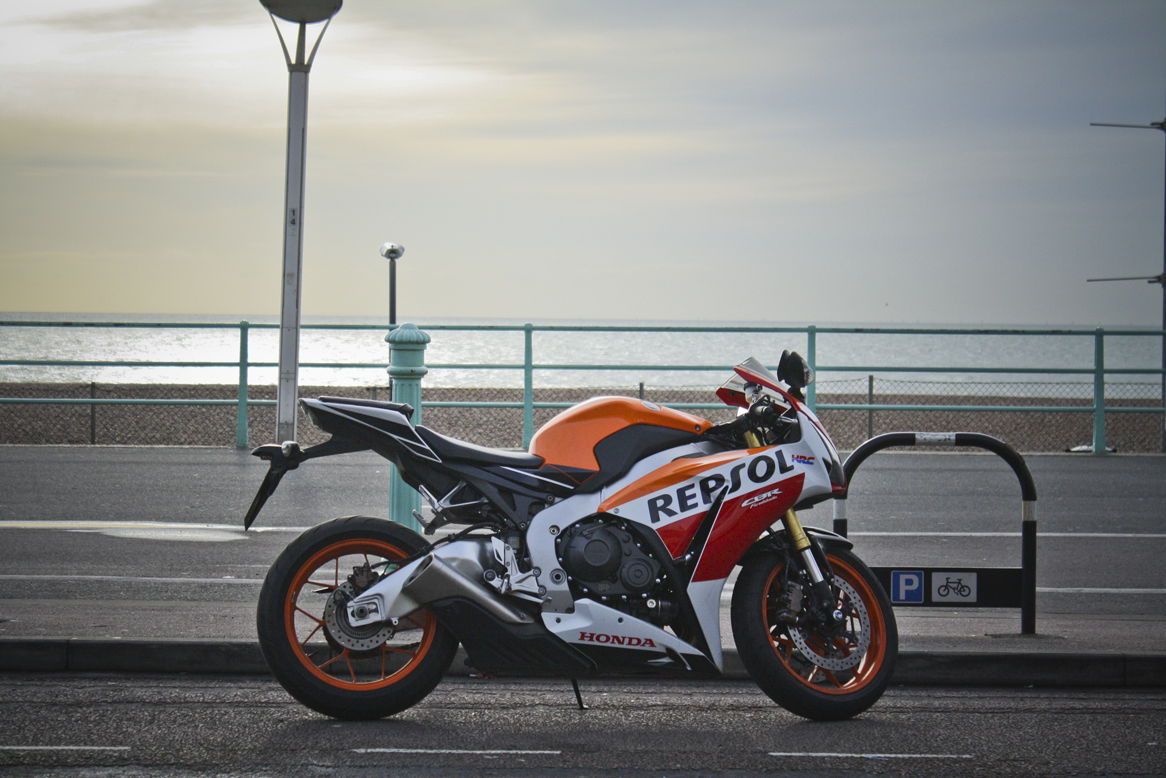UK road test: Triumph Street Triple 765 RS vs Yamaha MT-09
Can Yamaha’s ballsy budget blaster best Triumph’s top-of-the-range Street Triple?

LET'S HYPOTHESIZE that you’ve got a mate who espouses the virtues of three-cylinder engines at every opportunity; every time you meet him for a coffee at your local bike meet, he bangs on about how his beloved triples offer a perfect balance between smooth, high revving inline four-cylinder power and the mid-range grunt of a twin.
And that’s before he proceeds to tell you about the character of his favourite engine configuration.
You think you’re immune to it but over time, the constant pro-three-cylinder rhetoric starts to rub off. You find yourself wanting to suckle on the nipple of the triple…
Fortunately, you’re not short of choice. Two of the most exciting three-cylinder bikes to grace showrooms in 2017 are Yamaha’s eye-catching, budget priced and updated-for-2017 MT-09 and the new Triumph Speed Triple 765 RS – the range-topping model in the family of new Speed Triples. We plumped for the top-bollock RS not just because it’s got the most power and best spec of all the new Street Triples, but also because we wanted to see whether, if you’re in the market for a naked three-cylinder, you need to spend RS money to get the best bike.
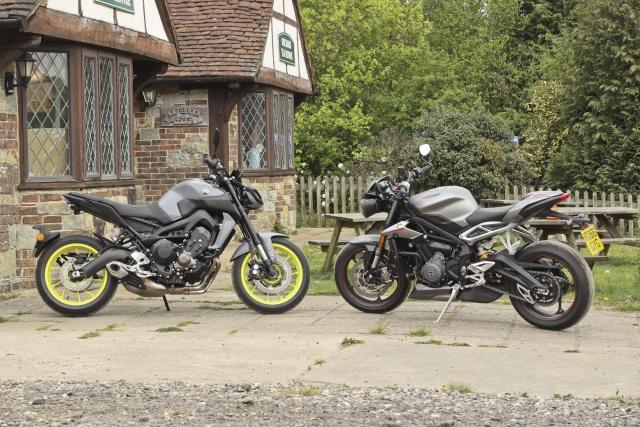
Indeed, Yamaha’s MT-09 is proof that if you’re looking for triple trouble, you needn’t spend big bucks because Yamaha’s asking price of £7,799 gets you an 847cc three-cylinder engine that makes 115hp and 65.5lb/ft torque. A quick power run on the Dyno at Steve Jordan Motorcycle in Bookham, Surrey revealed the MT-09 to be making 105.5hp at 10,811rpm and 55.93 lb/ft at 9,068rpm.
For 2017 the MT-09 has also had a restyle plus improvements to its suspension, plus its existing electronic aids (power modes, ABS and two-setting traction control) are now accompanied by a quickshifter.
Splash a bit more cash (£2,101, to be precise) on the range-topping Street Triple 765 RS and your £9,900 gets you Triumph’s 765cc three-cylinder motor, which makes a claimed 123hp and 57lb/ft torque. We stuck the RS on the dyno at Steve Jordan Motorcycles in Bookham and it made 121.48hp at 12,153rpm and 55.57lb/ft at 9,666rpm.
Like the MT, it’s also got a quickshifter, riding modes and traction control.
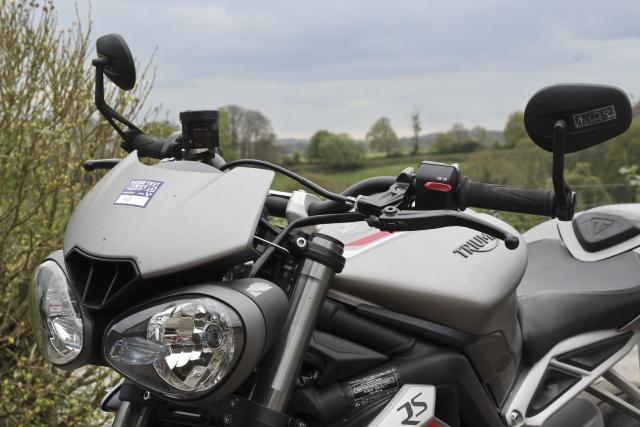
But there’s far more to the Street Triple 765 than that, so much so that it shames the MT-09 with its premium feel and the composed, assured ride it offers. The RS’s accomplished feel is evident before I’d even turned the key; the Triumph’s badges, lustrous matt silver paint finish and gorgeous rear subframe all indicate that it’s a classy bike. All this is accentuated once it’s sitting next to the MT-09. By comparison, the Yamaha looks like it’s awaiting a dash of colour to go over its primer grey paint job and its intakes and light front light assembly look plasticky, unsophisticated, perhaps even crude when sharing the same car park as the Street Trip’.
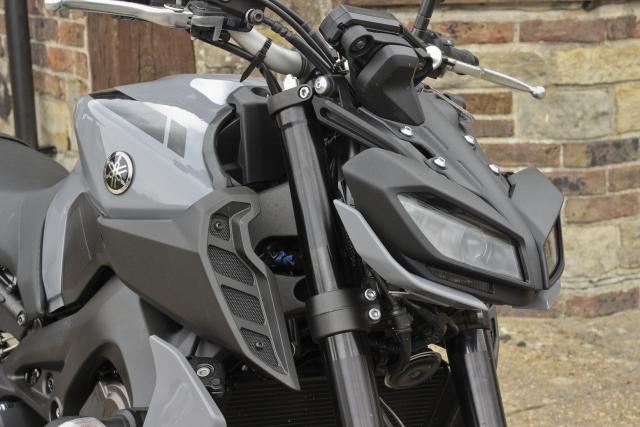
If the MT-09 were a piece of clothing in my wardrobe, it’d be my all-black Nike Tech tracksuit. The Street Triple RS would be my favourite grey suit. Unless I had a court appearance, I’d pick the tracksuit all day long – it’s more striking, bold and aggressive than a staid old suit. That’s exactly what the MT-09 is – it looks aggressive, modern, like something lifted from a Japanese manga comic. It’s edgy and I like it for that. It makes the Triumph look dull and safe – like a Street Triple. I don’t think the Triumph’s ugly, just a bit beige and I wouldn’t own one for fear of people thinking I was older and more sensible than I really am. And what of the restyle for this year? This bike could well be the previous generation of Street Triple.
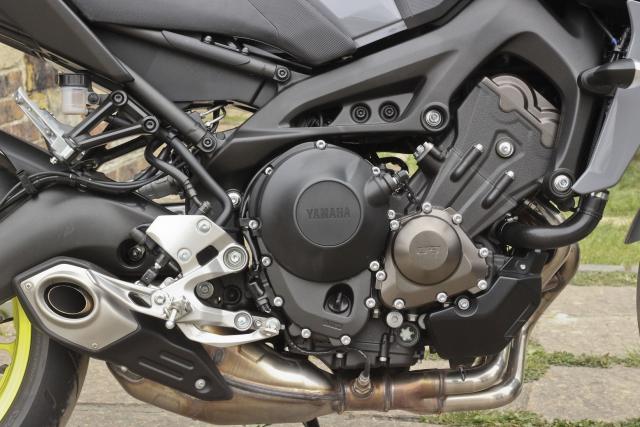
And the MT-09 is just as striking when you’re gunning it down the road. Although it’s down on horsepower compared to the Triumph, the MT blows the Trumpet away with its torquey power deliver, making it a more exciting bike on the road - interesting becasue although on paper the MT has a little more torque, the dyno revealed it to have only a fraction more torque. Crack the throttle and the MT-09 punches forward like a hoodlum legging it across council estate after robbing a helpless granny - the Yamaha’s CP3 engine delivers rampant shove throughout its midrange and up towards 10,000rpm. For city riding, screaming away from roundabouts and laying down power on your favourite winding road, the MT-09 feels strong like Arnie in the '70s and more characterful than the Striple, helped no doubt by how light it feels – 193kg wet with a full tank.
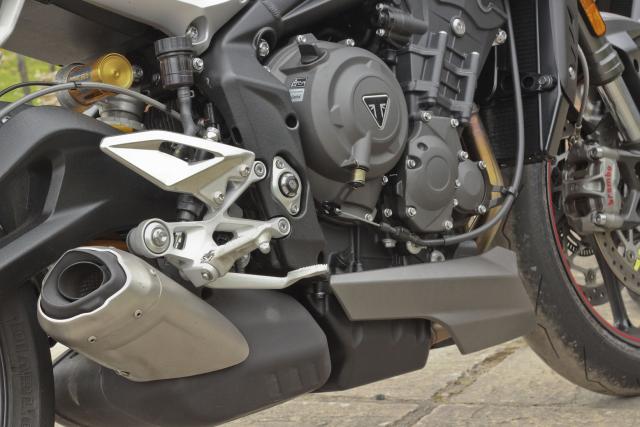
That’s not to say the engine in the Street Triple RS (claimed dry weight: 166kg) is boring. It’s gloriously smooth and linear. It invites you to wring every last drop of power from it before asking the quickshifter for another precise gear change. Keep it spinning above 8,000rpm and the rev counter charges for the redline with such a clean rush that you’d swear there was another piston pumping away in the block and because of the way the motor is so smooth and game for a thrashing, the Street Triple delivers a different experience to the MT – a more precise and refined experience.
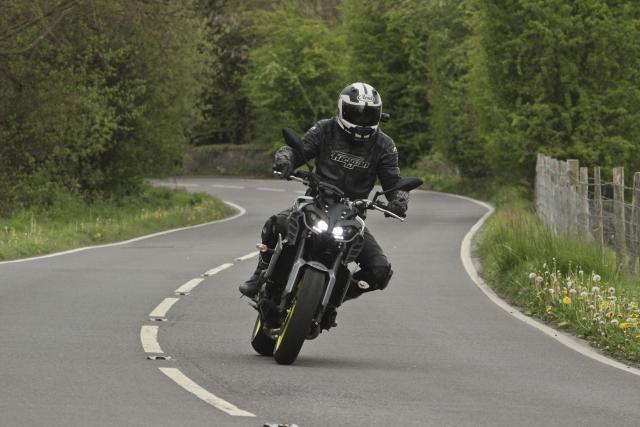
The MT-09 certainly feels a bit more unrefined compared to the Street Triple. In fact, it’s positively unruly. Where the Triumph has sweet fuelling and a lovely throttle response in whatever riding mode you have it in (Rain, Road, Sport, Track and Custom), the MT-09 can feel unpleasantly sharp in the most aggressive of its power modes (A) unless you’re being aggressive back. It can also feel a bit snatchy in standard mode when going from closed to open throttle. Although the MT-09 has a more exciting engine, it requires a more delicate touch, unlike the Street Triple, which has fuelling and electronics that are totally on your side as you push to explore what the engine’s offering.
THE YAMAHA'S edgy character continues through to the way it handles and when ridden back to back against the Street triple RS, the difference is obvious.
Both bikes use adjustable suspension front and rear – the Yamaha gets a 41mm upside down fork (with additional adjustment for 2017) and an adjustable shock. The Triumph has a Showa USD fork in the front and an Ohlins STX40 shock in the rear. No prizes for guessing which bike edges it in term of ride quality.
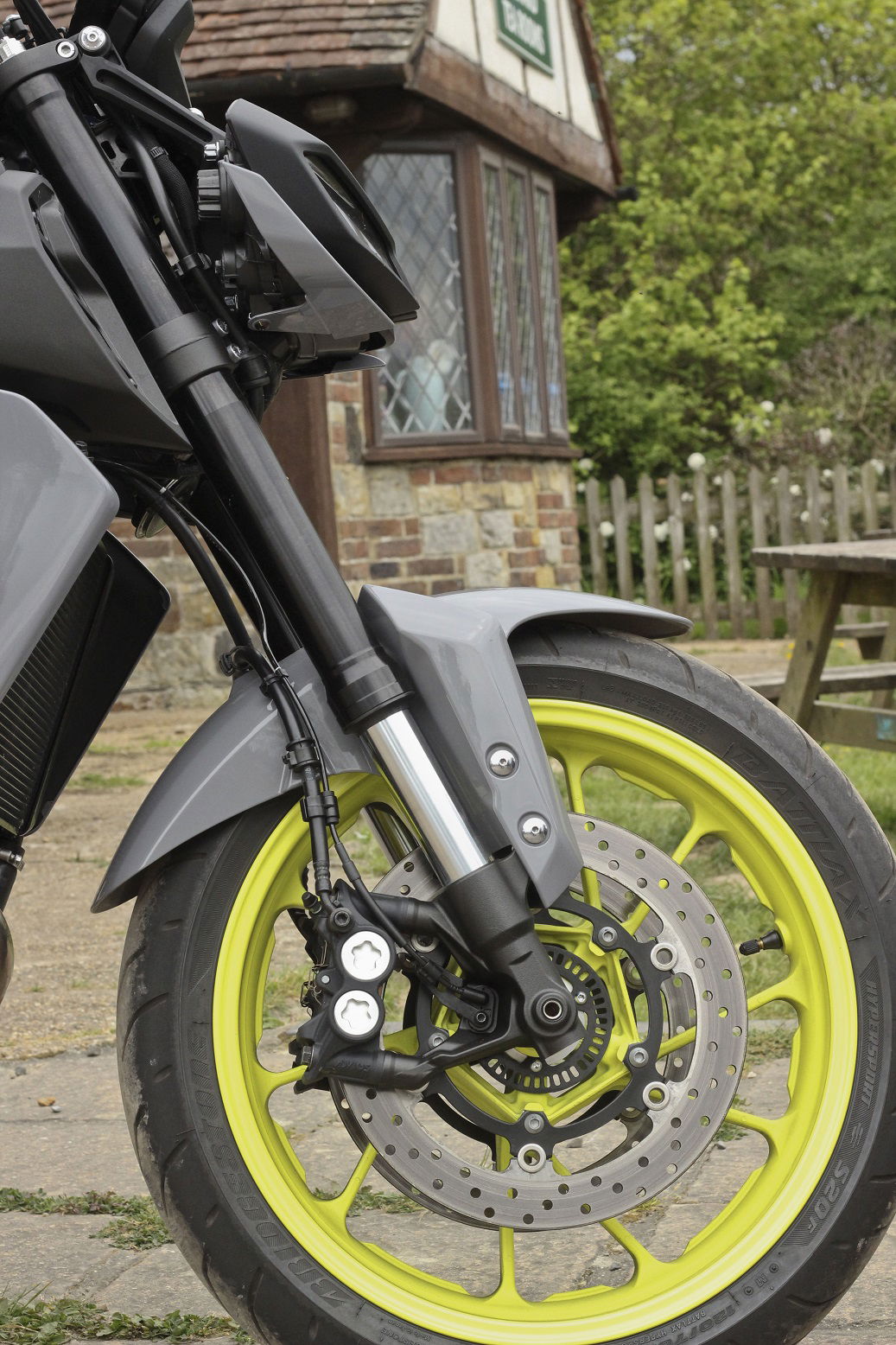
Yep, the Street Triple has a wonderfully assured and stable connection to the road and deals with British roads with ease. On the way in to a corner it delivers excellent stability and the confidence to do what you wish with the bike. The plushness with which it functions is sublime.
On the road, the Triumph’s standard settings felt more or less OK for me, but a sneaky track day at Snetterton meant some knob fiddling to make it feel a bit tauter – three clicks more compression at the front and some more preload in the rear. If owned one of these, I’d take it to someone who knows far more than me about suspension and get it set up for me, not because there’s anything wrong with the standard setup, but because the stock bouncers are so good that I expect a static setup to vastly really enhance the suspension’s performance and the ride feel.
The Yamaha has less of a polished suspension feel, although it’s by no means bad. The forks compress more keenly on the brakes and make a bigger deal out of road imperfections. The rear doesn’t feel quite as supportive and plush over bumps and under hard acceleration, but it’s nothing that a bit of adjustment won’t help fix.
But when jumping between both bikes, the difference in suspension is stark. After getting off the Triumph, the Yamaha immediately felt livelier and a bumpy stretch of road can begin to make it feel unsettled, as can hurling it into a bend with a little too much enthusiasm. The rear can bounce in corners and although it feels super light and steers quickly and effortlessly, it doesn’t deliver the plush ride feel of the RS.

The next round also goes to Triumph: brakes.
The Street Triple RS’s Brembo monobloc front brakes have the MT-09’s pair of four-piston stoppers beaten with ease. Feel through the lever is excellent, with good bite and bags of power. They were faultless on the road. On track, aggressive braking and the grip available from the Pirelli Supercosa SP tyres soon begins to be tempered by intrusions from the ABS, but that can be turned off. The Yamaha’s brakes are good - I never found myself wanting for more power and feel, but what’s on offer isn’t quite at the standard of the Triumph’s Brembo setup.
Both bikes are comfy and nearly free from ergonomic oddities, although Street Triple’s bar-end mirrors start to obstruct when you’re really hanging off.
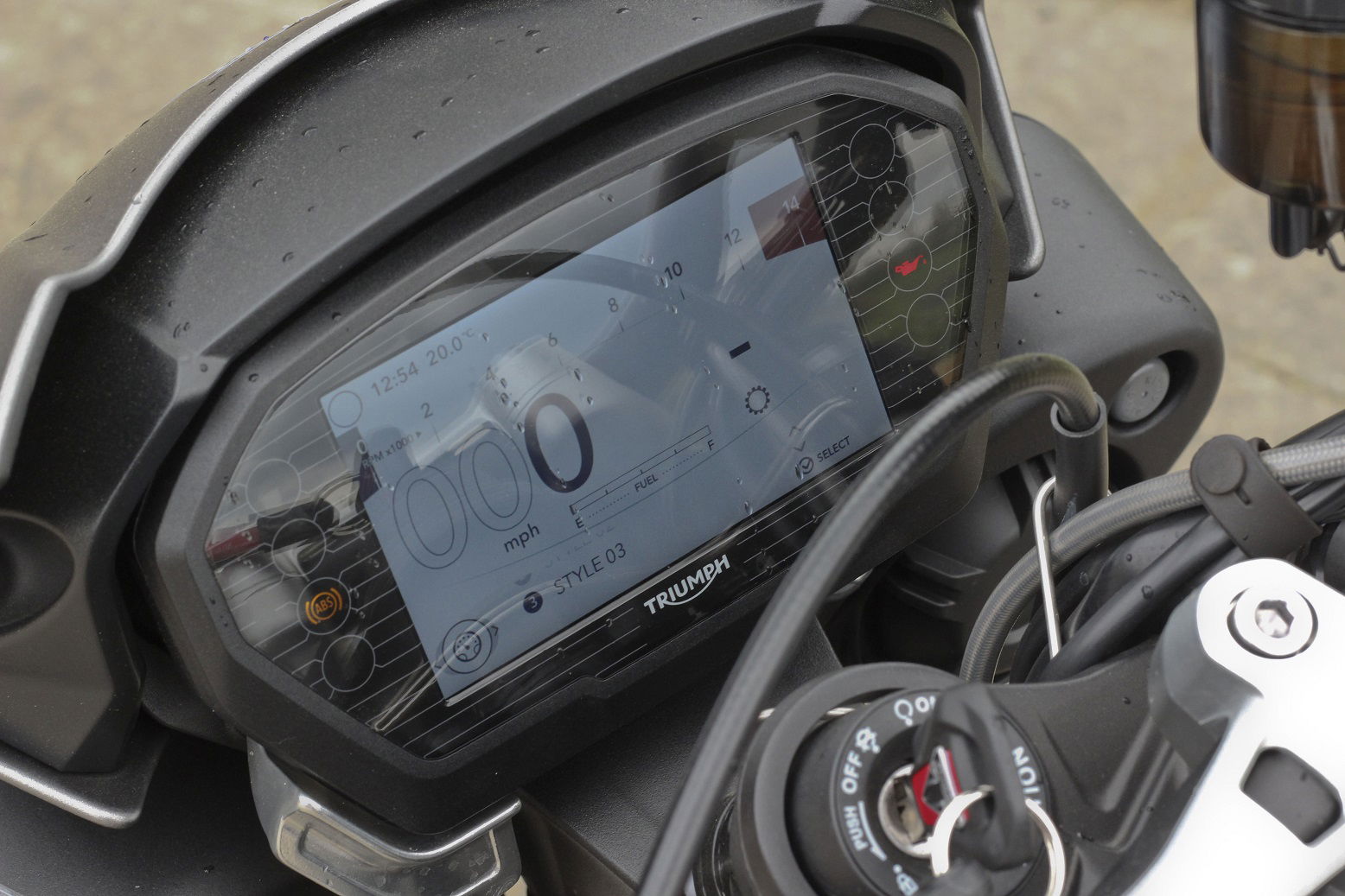
It’s the same with the instrument displays. The Triumph uses a colour TFT display that’s easy to navigate. It allows the rider to choose a few different styles of displaying the speed and rev counter, none of which I liked. The menus and electronic settings are easy to navigate thanks to a little joystick on the left switchgear, but when on the move, I found myself easily flicking the indicator when I wanted to switch riding modes or alter the display. The indicator button also needs to offer some more positive feedback because it feels like its come off an Atari controller, but now I’m just picking holes.
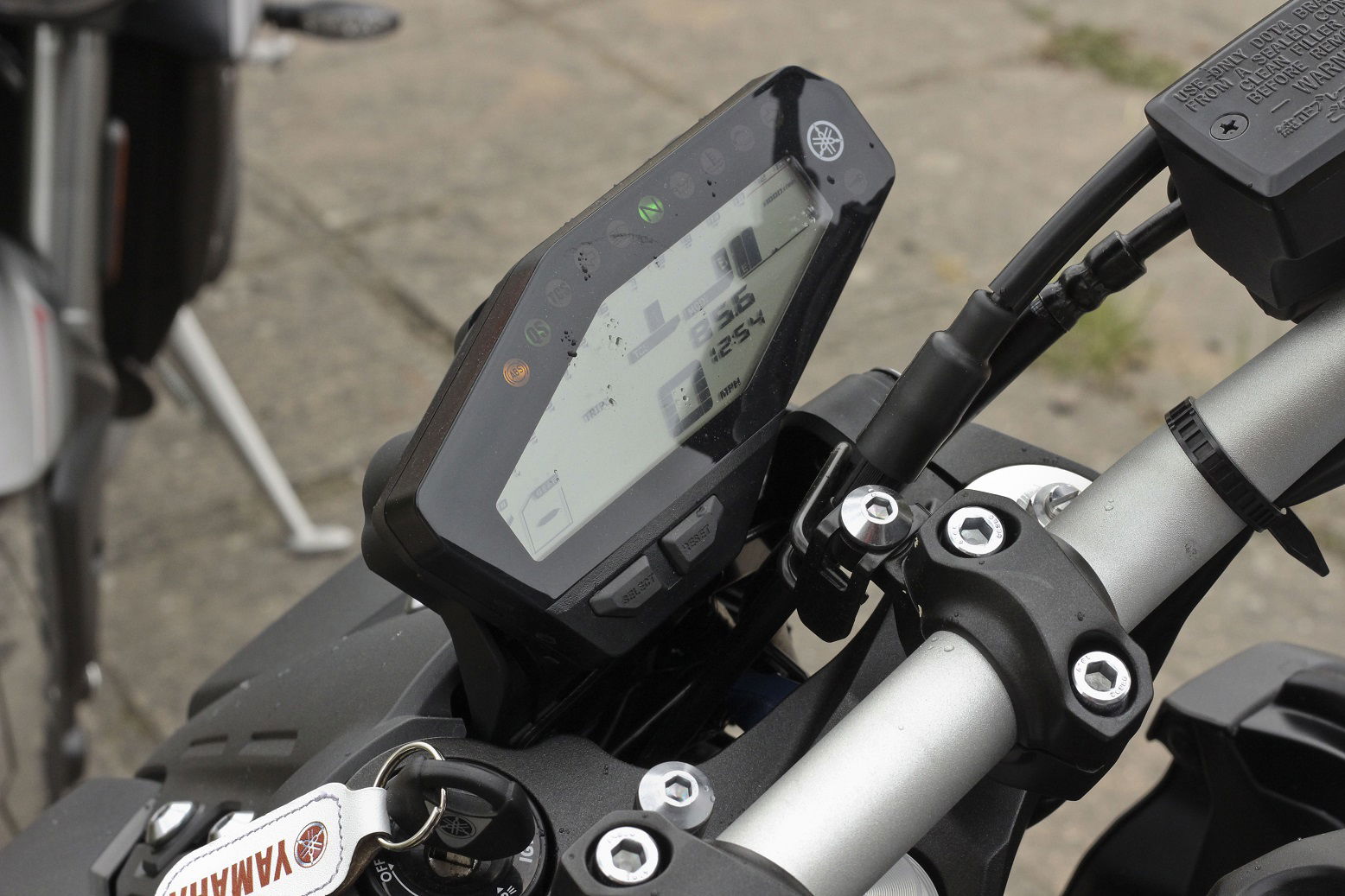
The MT-09’s controls are a simpler affair. All the useful, usual information is visible on a monochrome digital display that’s easy to read once you know where the information you’re after is displayed. The rev counter, which is wedged against the top edge of the diamond-shaped screen could do with being a little more prominent though. Switching between different riding modes and changing the traction control settings is simple thanks to a couple of buttons. I preferred the Yamaha’s simplicity over the Triumph’s all singing and dancing dash.
When it comes down to picking an outright winner, I’m struggling. I thought the Triumph would triumph over the cheaper Yamaha but although the Yam isn’t quite as polished as the Street Triple, it has more character and spirit about it.
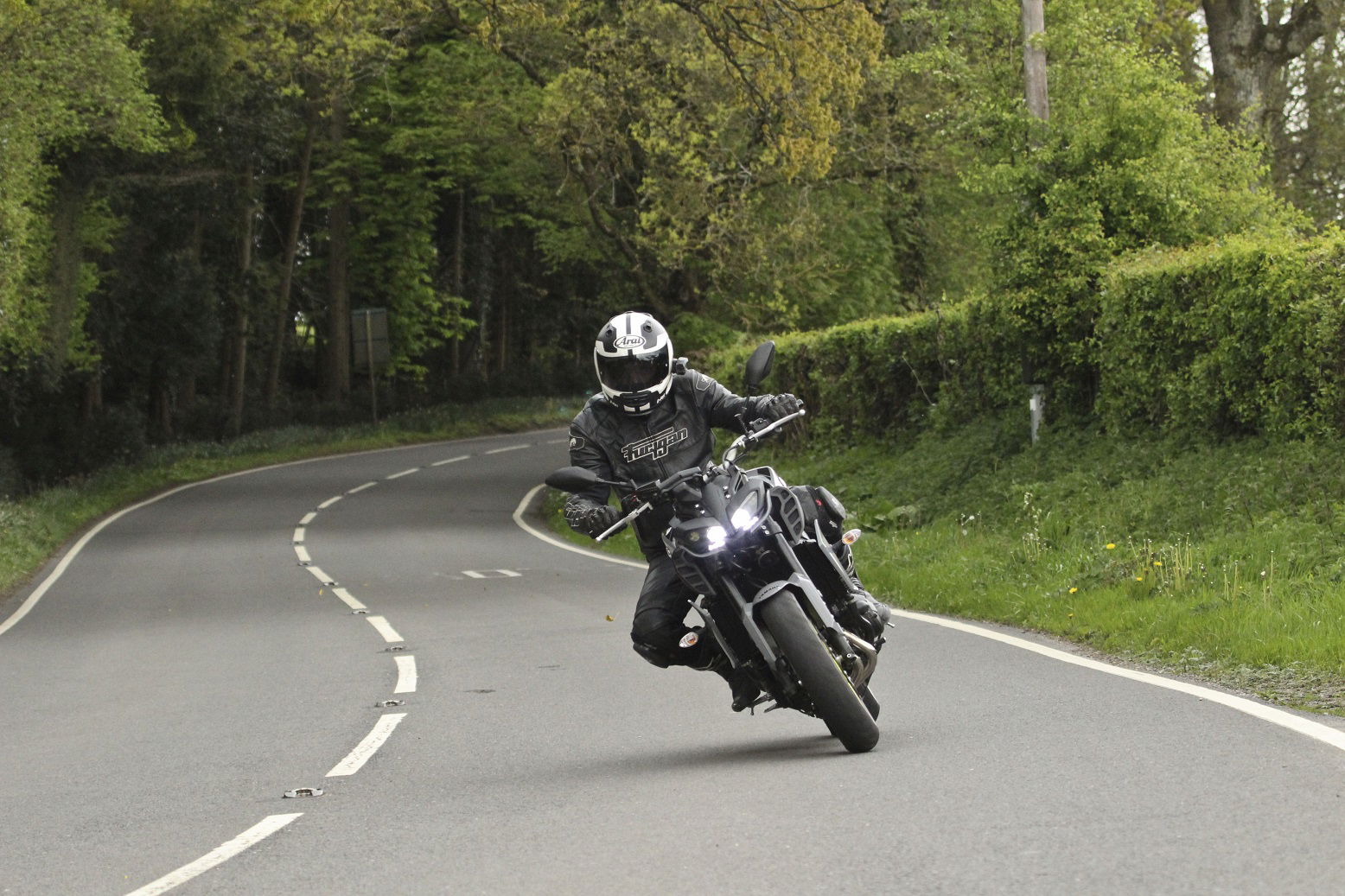
For the extra money you’ll spend on the Triumph Street Triple RS, it delivers a more rounded and accomplished package. There’s no doubting that it’s an excellent bike and it feels like the product of 10 years of Street Triple refinement and evolution. It’s more stable, precise and confident at being hurled around than the MT-09. And it has an engine and chassis that keep giving as you ride it harder, plus a better standard of finish. Oh, and it sounds great and is free of surprises. Really, there’s hardly anything wrong with it and compared to the MT-09, it’s a more grown up, sensible bike.
And that’s precisely what bugs me about it.
I feel naturally drawn to the more rough-around-the-edges MT-09 because I like that fact that it gets a reaction from people. Having ridden one and knowing that there’s plenty of attitude in the torquey engine, I’m tempted to pick the MT-09 as my winner because it offers raucous fun at the twist of the wrist and it standds out. However, against the Street Triple, it’s let down by its lack of refinement – it’s suspension isn’t quite on par with the Triumph’s and its overall finish certainly isn’t. Throttle response and fuelling are weak when against the Triumph’s too. But the thing that counts for me is that it has thanks to its engine and styling, it’s got loads more character than the Triumph and it’s hugely enjoyable because of that.
So here’s my inconclusive conclusion: if I was only going to ride on the road, I’d have the Yamaha MT-09, but for a bike to ride on the road and do the odd track day on, I’d pick the Triumph Street Triple RS.
Model tested: Yamaha MT-09
Price: £7,799
Engine: 847cc three-cylinder DOHC four-valve
Power: 115hp @10,000rpm
Torque: 64.5lbft @ 8,500rpm
Wet weight with full tank: 193kg
Frame: Diamond-type aluminium
Suspension: Upside down fork with separate damping controls, rebound on the right and compression on the left. Also adjustable for pre-load. Shock adjustable for preload and rebound damping.
Brakes: Radial four-pot calipers on 298mm twin floating front discs; single-pot caliper on 245mm rear disc. ABS.
Tyres: Bridgestone Hypersport S20s, 120/70x17 rear, 180/55x17 front, tubeless
Seat height: 820mm
Fuel capacity: 14 litres
Colours: Grey/yellow (‘Night Fluo’), silver/blue (‘Race Blu’), black (‘Tech Black’)
Availability: January 2017
Model tested: Triumph 756 Street Triple RS
Price: £9,900
Engine: 12v inline-triple, DOHC, liquid cooled, 765cc
Bore x stroke: 78x53.4mm
Compression ratio: 12.65:1
Power (claimed): 123hp@11,700rpm
Torque (claimed): 57ft lb@10,800rpm
Transmission: six speed, slipper clutch, chain
Frame: aluminium twin spar
Front suspension: 41mm fully-adjustable Showa USD forks (S has SFF forks, R has SF-BPF, RS has BPF
Rear suspension: Showa shock (S and R), Ohlins STX40 shock (RS)
Brakes: Nissin twin-piston sliding calipers (S), Brembo M4.32 four-piston radial calipers (R), Brembo M50 four-piston radial calipers (RS) 310mm discs (front) 220mm disc, single-piston Brembo caliper (rear)
Wheels/tyres: cast alloy/Pirelli Diablo Rosso Corsa/Supercorsa (RS), 120/70 17 front, 180/55 17 rear
Rake/trail: 24.8°(S) 23.9° (R&RS)/104.3mm (S) 100mm (R&RS)
Wheelbase: 1,410mm
Dry weight (claimed): 166kg
Fuel capacity: 17.4 litres
